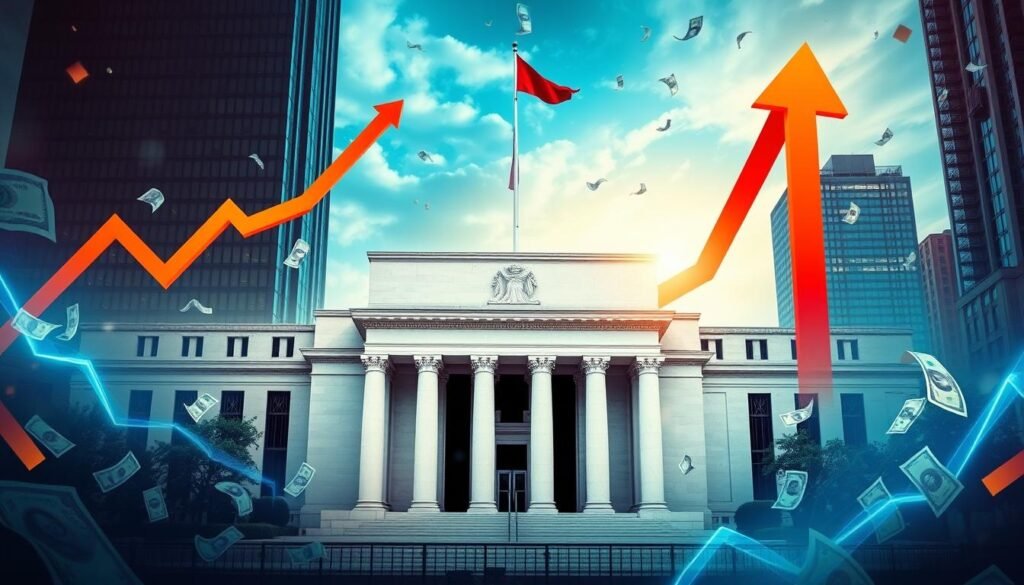How Federal Reserve Interest Rate Hikes Affect the Economy and Your Wallet
The US economy is facing a tough time, and the Federal Reserve is at the forefront. They’ve cut interest rates in 2024. In December, they lowered the federal funds rate to 4.25% to 4.5%. This is a 1 percentage point drop since September1.
But the Fed’s plans have changed. They now think they’ll cut rates by only two points in 2025. This is less than the four cuts they expected in September1. This shift has caused market ups and downs and worries about future rate hikes.
It’s important to understand the Fed’s new strategy and its effects on the economy2. Looking at current interest rates, policy decisions, and economic signs can help. This way, you can see what the US central bank has in store for us.
Current Federal Reserve Rate Environment
The Federal Reserve has been working hard to control inflation by raising interest rates. This has created a dynamic rate environment that affects everyone and the economy3. Recently, the Fed cut the federal funds rate by 25 basis points, setting it between 4.25 and 4.5 percent3. This change caused big drops in the S&P 500 and the Dow Jones, showing how the Fed’s actions impact markets3.
Federal Funds Rate Target Range
The Fed decided to slow down rate cuts for 2025 because of higher inflation in 20243. In November, inflation was 2.7 percent, down from over 9 percent in mid-2022. This shows the Fed is making progress in fighting inflation3. But, the 10-year Treasury note rate is still high, at about 4.37 percent, showing borrowing costs are still a challenge3.
Recent Economic Indicators
Recent economic signs are mixed. The Commerce Department revised third-quarter growth to 3.1 percent. The Atlanta Fed’s GDPNow forecast also expects 3.1 percent growth in the fourth quarter, showing no economic slowdown3. But, personal loan rates are now 12.29 percent, up from 9.38 percent in 2021, when rates were near zero. This shows the Fed’s rate hikes are making borrowing more expensive3. Mortgage rates have also gone up since the Fed started cutting rates in September, affecting homebuyers3.
The Federal Reserve is carefully watching the economy as it makes policy decisions. These decisions affect inflation, borrowing costs, and the overall economy34.
| Indicator | Current Value | Previous Value | Trend |
|---|---|---|---|
| Federal Funds Rate Target Range | 4.25% – 4.5% | 4.5% – 4.75% | Decreased |
| Annual Inflation Rate | 2.7% | 9% | Decreased |
| 10-Year Treasury Note Rate | 4.37% | 4.99% | Decreased |
| Average Personal Loan Rate | 12.29% | 9.38% | Increased |

US Federal Reserve Interest Rate Hikes and Their Economic Impact
The Federal Reserve’s interest rate decisions have greatly affected the U.S. economy. Despite rate hikes, the economy has grown, beating other developed countries5. The Fed tries to balance economic growth and fight inflation5.
There’s a chance for more rate hikes in 2025 because of strong growth and inflation5. Market expert Ed Yardeni believes the Fed might not cut rates as much as expected in 20255.
| Economic Indicator | Impact |
|---|---|
| Federal Funds Rate Target Range | The Federal Reserve cut short-term interest rates by a quarter-point on December 18, reducing the expected rate cuts in 2025 from four to two5. |
| Inflation Management | Progress on getting the inflation rate back to 2.0% was forecasted to take until 2027, but the Fed’s latest inflation forecast released at its September meeting was more optimistic than the one in December5. |
| Treasury Yields | The 10-year Treasury yield increased to 4.6% post-Fed rate cut, while rates on super-safe money market funds are expected to edge closer to 4%5. |
| Corporate Bond Yields | Top-rated corporate bond yields, such as AAA-rated bonds, increased in line with Treasury yields before the Fed’s announcement, reaching 4.8%5. |
| Mortgage Rates | 30-year mortgage rates were predicted to inch closer to 7.0% as the Fed’s actions aim to reduce its Treasury securities portfolio5. |
The Federal Reserve’s policy decisions have big effects on the U.S. economy. There’s a chance for more rate hikes in 2025 to fight inflation5. As the central bank makes these decisions, everyone will watch the economy closely5.

“The Fed chair anticipates that lower interest rates will boost the economy and support hiring.”5
Federal Reserve’s Inflation Management Strategy
The United States Federal Reserve is working hard to lower inflation to 2% annually. But, inflation rose 2.7% in November 2024, slower than hoped67. Housing and food prices are still high, making it tough to beat inflation.
Progress Toward 2% Inflation Target
Experts think inflation might hit 2.5% in 2025, up from 2.1% before6. The Federal Reserve is still aiming for 2% inflation. This goal guides their decisions on interest rates.
Consumer Price Index Trends
The “core” inflation rate, excluding food and energy, was 2.8% in October 20246. This is higher than the Federal Reserve’s 2% goal. The bank is worried about inflation and is looking to cut borrowing costs.
Housing and Food Cost Considerations
Housing and food prices are still high, making inflation hard to control67. The Federal Reserve is watching these areas closely. They want to see how they affect overall prices.

“The Federal Reserve’s inflation management strategy, driven by federal reserve interest rate decisions, remains a top priority as the central bank continues to navigate the complex economic landscape and its impact on consumer prices.”
The Federal Reserve is slowly moving towards its 2% inflation goal. Housing and food costs are big factors in this slow progress. The bank is dedicated to its inflation target, guiding their interest rate decisions to achieve price stability67.
2025 Rate Cut Projections and Market Expectations
The US Federal Reserve has updated its rate cut plans for 2025. Now, they expect only two cuts, down from four8. The federal funds rate is expected to hit 3.9% by the end of 2025, up from 3.4% before8.
This change has made the market more uncertain about future rate cuts. Some think the Fed might skip a rate cut in January 2025 and then ease in March8. The market has reacted negatively, worried about a slower easing pace8.
The Fed’s new plan includes a possible pause in January before easing again in March. This is due to stronger growth and higher inflation expectations89.
The Federal Open Market Committee (FOMC) has lowered the target federal funds rate by 25 basis points. Rates now sit at their lowest since February 20239. This marks a full 1% in cuts for 2024, with hopes for more inflation progress in 2025, unless tariffs disrupt this8.
The market has reacted negatively to the Fed’s updated plans. Stocks have fallen, and treasury yields have risen8. Yet, the Fed is easing more slowly, with a hawkish outlook on inflation and unemployment8.
Inflation has been over 3% for 43 months, the longest since the early 1990s8. The Fed now expects 50 basis points of easing in 2025, down from 100 bps in September8.
Political Transition and Monetary Policy Implications
The United States is getting ready for a new president in 2025. This change could affect interest rates and monetary policy in many ways. The new administration’s plans, like tax cuts and higher tariffs, might lead to higher prices. This could make it harder for the Federal Reserve to keep interest rates stable1.
Potential Trade Policy Effects
The Fed is watching how the new administration’s trade policies might affect the economy. Higher tariffs could lead to inflation and change interest rates. The central bank is being cautious, waiting to see what policies will really happen1.
Economic Growth Forecasts
“Despite the uncertainty, the Fed believes the economy will grow well in 2025, with solid economic performance expected. Federal Reserve interest rate decisions will be influenced by the labor market and wages, as the Fed aims for stable prices and jobs.”
Immigration and Labor Market Impact
Changes in immigration policies could also affect the labor market and the Fed’s decisions. The central bank will look at how these policies might impact labor and prices1.
The Federal Reserve will face new challenges as the political scene changes. They will adjust interest rates as needed to keep the economy stable. Their success in managing money during this time is key for the U.S. to grow and thrive11010.
| Key Data Points | Current Outlook | Previous Outlook |
|---|---|---|
| Federal Funds Rate Target Range | 4.25% – 4.5% | 4.5% – 4.75% |
| Rate Cut Forecast for 2025 | 2 rate cuts | 4 rate cuts |
| Projected Federal Funds Rate by End of 2025 | 3.9% | 3.4% |
| Inflation Forecast for 2025 | 2.5% | 2.1% |
The upcoming political change in the U.S. will impact the Federal Reserve’s monetary policy and interest rate decisions. As the central bank deals with these unknowns, it’s important for policymakers to watch the economy closely. They need to consider trade policies and labor trends to keep the American economy stable and growing11010.
“The Fed is taking a wait-and-see approach to potential policy changes, acknowledging uncertainty about the actual policies to be implemented.”
Conclusion
The US Federal Reserve is always adjusting interest rates. They aim to grow the economy while keeping inflation in check11. Recent rate cuts have helped borrowers, but 2025 might see a more careful approach to lowering rates11.
Strong economic growth, new policies, and ongoing inflation make future rate decisions uncertain. Investors and consumers need to watch economic signs and the Fed’s talks12. Things like job growth, housing, inflation rates12, and mortgage options12 are key to the Fed’s plans.
Understanding the Fed’s moves is vital for making smart money choices13. Their decisions, like more rate cuts or slower reductions11, affect your money, investments, and the US economy.
FAQ
What is the current federal funds rate target range set by the Federal Reserve?
How has the Fed’s decision to slow the pace of rate cuts for 2025 impacted the markets?
What are the recent economic indicators for the U.S. economy?
How is the Federal Reserve’s inflation management strategy progressing?
What are the Federal Reserve’s projections for rate cuts in 2025?
How could the upcoming political transition affect monetary policy?
Source: youtube.com | Related articles: Article 1 / Article 2




